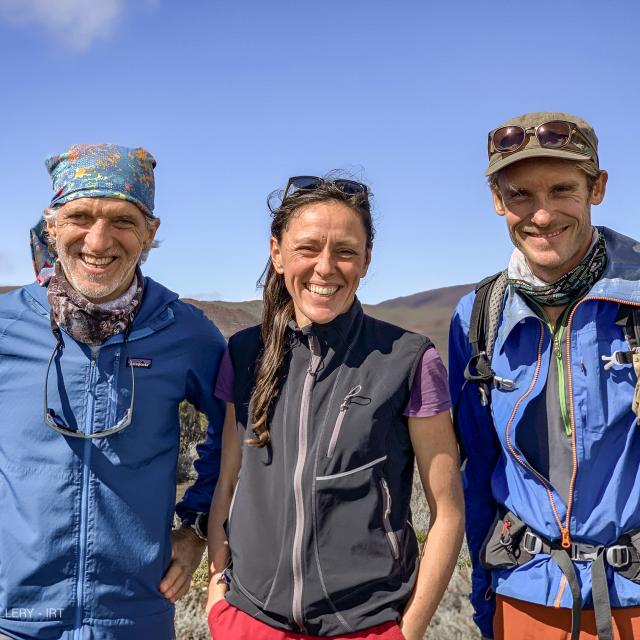
A real moment to share and talk about heritage and UNESCO World Heritage.

A real moment to share and talk about heritage and UNESCO World Heritage.
For Amandine: diversity everywhere. For Alexis: A jewel to be protected. For Didier: Such an infinitely small island that offers great sensations and emotions infinitely.
For Amandine: Meeting, sharing and scenery. For Alexis: By the sea or in the mountains. For Didier: New getaways.
For Amandine: the core zone of La Réunion National Park. For Alexis: Piton des Neiges. For Didier: A hidden place in the heart of the island.
For Amandine: Man and nature. For Alexis: If only I had just one. For Didier: Life.
For Amandine: anything prepared with love. For Alexis: My grandmother’s morel chicken. For Didier: Egg in chili sauce.
For Amandine: those who stir up emotions. For Alexis: Xavier Rudd. For Didier: Davy Sicard.
In 2010, ‘Pitons, Cirques and Ramparts of Reunion Island’ were inscribed into the UNESCO World Heritage List. The core zone of La Réunion National Park is recognised around the world for its exceptional biodiversity and unique landscape features. This inscription is an achievement and a point of pride for the island and its people
Amandine, Alexis and, Didier are state-qualified tour guides. They share the view that a heritage site such as this must be accessible to as many people as possible and must also be a place for raising awareness. With this, they offer a guided excursion to explore this UNESCO World Heritage site at Plaine des Sables, a few steps from Piton de la Fournaise.
The scene is set. Our small group of hikers is ready to spend a morning exploring the area around the volcano, and in turn, exploring and sharing this heritage site.
The sun rises on Plaine des Sables just as I join our tour guides for this morning excursion at the heart of this iconic World Heritage site on Reunion Island.
It’s 7:30am and a fresh breeze is waking up my sleepy muscles. In front of me, the Plains and its stretch of red-tinted scorch marks create a breathtaking and moon-like panorama.
We are going to be exploring this protected natural environment for a few hours, so preventative measures should be taken before we start the excursion. One by one, we are asked to scrub the soles of our shoes to avoid spreading foreign invasive species during our hike. Doing this is not only fast, but also surprisingly useful, especially when we see the seeds fall out!
While we have a cup of homemade herbal tea, and nibble on a few snacks to give us strength and warm us up before the hike, our tour guides of the day explain the unique hiking route through which we will be exploring UNESCO World Heritage on Reunion Island.
To start, we’re going to hike the length of the Pas des Sables ‘remparts’ (escarpments) via Sentier Mouton. After this, we’re going to visit Plateau des Basaltes for a picnic break. The hike will end at the bottom, with a moonwalk through Plaine des Sables before going back to the carpark. Good news: this loop trail is accessible to all!
The majestic Piton des Neiges watches over us during this quick introduction. Piton des Neiges is another unmissable UNESCO World Heritage Site on Reunion Island. It will be following us for a good chunk of the morning.
It’s time to get walking!
We start the hike, laughing and joking.
Throughout our route, our tour guides stop us from time to time to explain and talk about the different aspects of what makes up a UNESCO World Heritage site like Reunion Island.
This is how I learnt about the origins of our majestic volcano, Piton de la Fournaise standing tall before us, the reasons for the world-renowned multiple microclimates on the islands, as well as the rich and fragile nature of our biodiversity, etc.
Throughout the hike, I also learnt about new landscapes and new atmospheres. I was surprised to see this arid landscape become greener the further we walked. At Piton des Basaltes, the view of the Rivière de l’Est is magnificent. We continued along the first path, bringing us to Piton de la Fournaise, one of the most active volcanoes in the world. This area is an ideal place to contemplate the position and role of humans in this both hostile and protected environment.
At times, our tour guides take us back in time by reading excerpts from ancient books. They show us photos and maps and tell us anecdotes with the intention of helping us better understand UNESCO World Heritage on Reunion Island.
We begin to descend towards Plaine des Sables via the meandering paths of the ‘rempart’. Surprisingly, we ended up on an islet, dotted with Petits Tamarins des Hauts (Sun King) trees, at the bottom of the Plateau des Basaltes. It’s the perfect spot for a picnic break. Réunion grey white-eye birds come to say hello, while our tour guides ask us to write something about Reunion Island’s endemic fauna.
We finally begin our hike across Plaine des Sables to get to the carpark. For this last part, our tour guides offer to take us back (and then forward) in time. The years pass by as we walk, allowing us to take a step back in time.
Our hike ends on an optimistic note thanks to our tour guides. ‘In the end, we have done so much in so little time to protect this UNESCO World Heritage site on Reunion Island. Imagine what’s left to come in the years to come. Nothing is lost, nothing is final, everything remains to be done!’
Let’s meet here in 10 years!
The Esprit parc national label awarded to this excursion is a sign of quality for this eco-responsible and enriching experience in the exceptional La Réunion National Park.